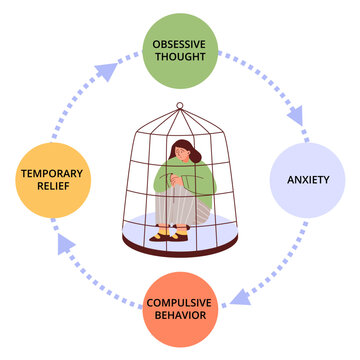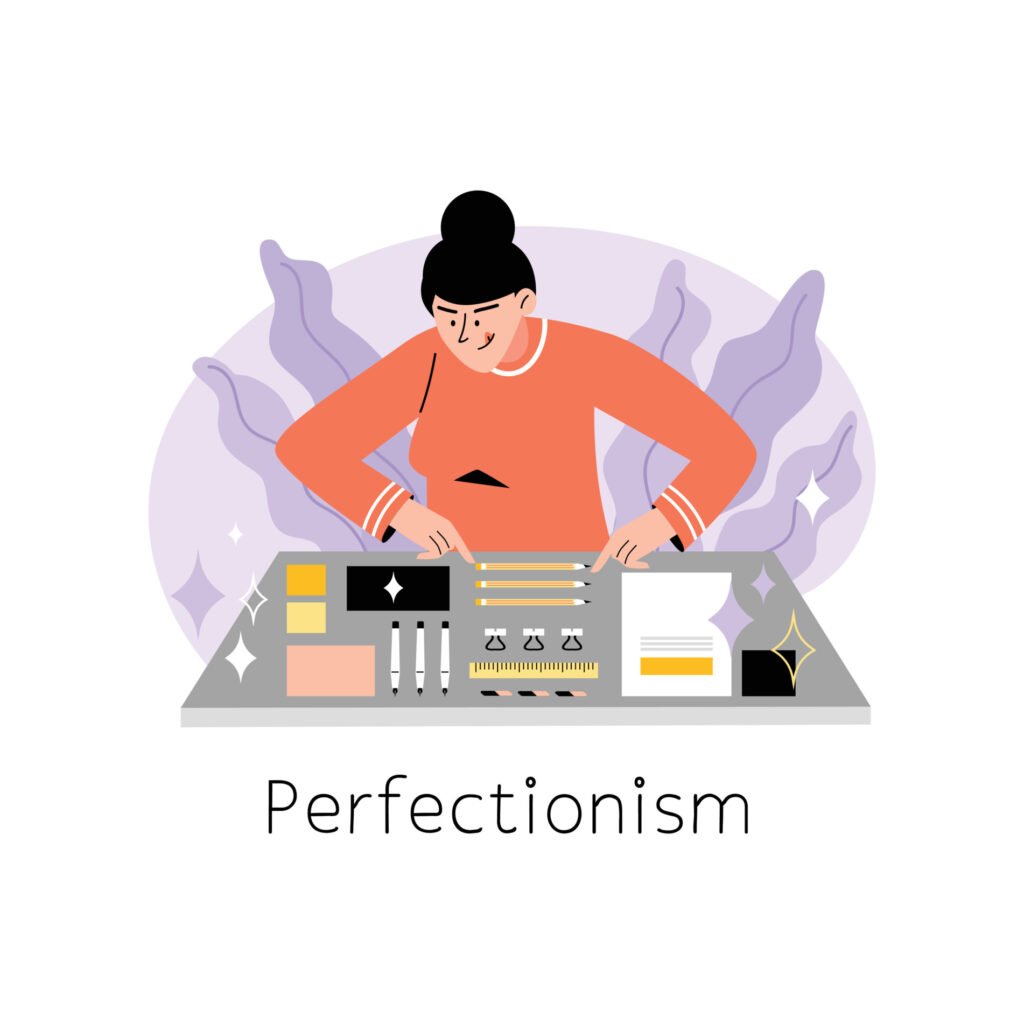On This Page:
Orderliness and Symmetry OCD is a subtype of Obsessive Compulsive Disorder (OCD) characterized by ongoing intrusive thoughts and compulsive behaviors surrounding sameness, orderliness, balance, and symmetry.
This subtype of OCD shares similar symptoms with Perfection (Just Right) OCD.

OCD is a mental disorder categorized by an endless cycle of obsessions, anxiety, and compulsions.
People with symmetry OCD will experience frequent obsessions around things not feeling symmetrical or ordered. They will become fixated on the position or arrangement of certain objects and will feel uncomfortable and distressed when items are not aligned correctly or appear in disarray.
“As a child if my left shoulder bumped into something I would focus (unhappily) on how my right shoulder felt weird or dirty until I could go back to the same spot and bump my right shoulder”.
People with this form of OCD may also struggle when written words are shaped imperfectly or are not correctly positioned along the lines on a page. These obsessions with symmetry tend to make individuals feel very uncomfortable and distressed with anything that does not meet their sense of order.
As a result, people with this form of OCD will compulsively fix, order, or rearrange items in an attempt to position objects in a perfect and acceptable manner, or will rewrite handwritten words over and over again until they appear aligned.
Individuals might experience a sense of dread or unease that something bad will happen unless they engage in compulsive behavior to neutralize it.
Research has shown that about 36-50% of people with OCD have this subtype (Lochner et al., 2016; Vellozo et al., 2021).
Symmetry OCD Obsessions
An obsession is an intrusive, unwanted thought or urge that can pop into one’s mind anytime. People with OCD will dwell on these intrusive thoughts and experience significant anxiety or distress.
Some common obsessions that occur with Symmetry OCD include:
- The urge to arrange and order things → Someone with this type of OCD will feel an overpowering urge to arrange objects in a symmetrical way.
For example, they might organize clothes in a closet, pillows on a bed, objects on a shelf, food in a refrigerator, or items in a drawer.
They might experience these urges in their own home, a friend’s house, a workplace, a restaurant, the supermarket, etc. People with this OCD subtype might also feel the need to touch or pick up items in a certain way or in a certain order.
- The need for balance → Individuals with Symmetry OCD also may experience a need to make their behaviors feel balanced.
For example, if they are walking, they might feel an urge to place the same amount of pressure on each foot, or if they are sitting at their desk and move one foot, they may experience a powerful urge to move their other foot in the exact same way.
Other examples can include needing to tie the shoe on their right foot to match the tension of the shoe on their left foot, or needing to touch their left shoulder if someone accidentally touches their right one to make it even.
- Intense fear and anxiety → People who experience Symmetry OCD obsessions will typically be faced with extreme fear and anxiety, usually due to something terrible happening to themselves or someone they love if an object is uneven or imperfectly aligned. They dread what might happen if things do not line up with their need for perfect order.
- Discomfort with anything asymmetrical → In addition to the fear and anxiety caused by their obsessions, individuals with Symmetry OCD also have an intense distrust of asymmetry, or things “not lining up evenly.”
Asymmetry will often invoke a sense of discomfort and uneasiness, even in situations they do not necessarily find triggering. - A feeling of incompleteness → Some people with Symmetry OCD will also feel a sense of incompleteness or that things are “not right” when they experience asymmetry.
They will experience a nagging, persistent feeling that things are “off” or imperfect, thus driving the urge to carry out compulsions and make things symmetrical.
Because these obsessions cause high emotional discomfort, people with OCD will perform ritualistic behaviors to lessen these feelings and manage their distress. These are referred to as compulsions.

Symmetry OCD Compulsions
Compulsions are behaviors or rituals that people with OCD perform in response to an obsession. People perform these compulsions to suppress their anxiety and neutralize their fears. They also carry them out to keep things safe, ensure that the thoughts do not come true, and/or that something bad does not happen.
Even if the individual is aware that their compulsions are not logical, they are still compelled to carry them out, either for fear that something bad will happen if they do not, or because they feel incredibly anxious and distressed.
Some common compulsions that are seen with Symmetry OCD include:
- Arranging and ordering → Symmetry OCD compulsions more often than not focus on arranging and ordering items to meet the individual’s need of “just right” or “perfection.”
This can include organizing items by color, size, or number, or arranging items to meet a certain aesthetic. Examples might include:
- Positioning items so that there is the same amount of space in between them
- Ordering/arranging book on a shelf by color or size
- Organizing items on a supermarket shelf to meet their standards
- Lining up or arranging their clothes or shoes in their closet according to a certain method or set of rules they set in your mind
- ‘Evening up’ → Other Symmetry OCD compulsions may focus on “evening up” items or behaviors.
This essentially means ensuring that items or words are evenly spaced or balanced, and behaviors are equalized. Examples might include:
- Tying shoes so they are equally tight on both sides
- Touching the left knee to feel symmetrical if something bumps against the right one
- Writing the exact number of words on each line on the page
- Counting steps so you step exactly the same number of times with the right foot as with the left one
- Lining up the food on a plate to ensure it is all facing the same way and evenly spaced
- Adjusting books on a bookshelf, so that the spines all form one even line.
This real-life personal experience captures the compulsive need for balance and evening up:
“If I touch something with my left hand, like a table, I HAVE to touch the same exact spot with my right hand. This extends to the part when and if I scratch my one ear, I have to scratch the other one too (even if it’s not itching) for the same amount of time I scratched the first one.”
- Avoidance → Similar to most other forms of OCD, avoidance is a common compulsion.
Because people with Symmetry OCD experience high levels of anxiety and disstress when things appear to be asymmetrical or uneven, they might avoid certain situations where they know their OCD will likely be triggered.
This can include avoiding odd numbers, situations with the potential for asymmetry, or places that remind them of their negative emotions associated with their obsessions. Examples might include:
- Avoiding rooms or areas that have asymmetrical geometric shapes, such as floors with uneven tiles or walls with crooked lines
- Counting while performing actions to leave off on an even number (walking, writing words, chewing)
- Rounding numbers up or down to make them even to avoid odd numbers
- Re-doing → Many OCD compulsions focus on the need to re-do, re-check, or re-arrange. This is because most OCD sufferers experience extreme self-doubt, and thus do not trust themselves or their memories.
As a result, they often need to re-arrange, re-order, or even up items or actions until they feel ‘just right’ or until they can be certain that they are organized correctly. Examples might include:
- Rewriting words or letters on the page until there are no visible imperfections or asymmetries in the writing
- Rearranging items in the fridge or the pantry over and over again until it feels perfect and symmetrical
- And, even after arranging the fridge or pantry in a way that feels right, going back to check again to make sure that things are as perfectly arranged as you left them.
Why Am I Obsessed with Order?
Reasons behind Symmetry OCD include magical thinking, dysfunctional protecting, and the simple need to feel right.
- Magical Thinking → Individuals with obsessions about symmetry and exactness also might experience magical thinking, or superstitions, associated with their fixations.
They might worry that something bad will happen to themselves or a loved one unless things are in just the right place.
They might even feel responsible if something bad happens if they do not perform a specific compulsion to counter the obsessive thought.
Although people with OCD realize these thoughts are irrational, they will feel a sense of angst or discomfort unless they give into the obsession, thus fueling the OCD cycle. - Dysfunctional Protecting → Similar to all forms of OCD, people with Symmetry OCD believe that by completing compulsions, they are protecting themselves and those around them. Completing compulsions allows people with OCD to feel safer and more in control.
- Needing to Feel Right → Like Perfectionism OCD, individuals with Symmetry OCD are obsessed with the need for things to look, sound, or feel “just right.”
They will not feel satisfied or comforted until symmetry is attained, and therefore might spend hours a day completing compulsive behaviors.
Effects On Daily Life
The severity of one’s OCD symptoms and their impact on one’s daily life will vary from individual to individual. For some, they may find that their triggers are specific and easy to target and manage, while others with more general triggers might notice that they constantly feel overwhelmed in daily life situations.
In all cases, however, living with OCD is very challenging and can take a toll on one’s physical and mental health wellbeing.. When left untreated, it can infiltrate nearly every aspect of someone’s life.
Symmetry OCD obsessions can be all consuming and feel impossible to stop. Individuals with Symmetry OCD will spend hours a day ruminating on their obsessive thoughts and engaging in compulsive behaviors.
They typically find their urges very hard to ignore, making it difficult to focus on what is happening in the moment. They will likely be very fixated on these feelings to the point where they are completely possessed by them.
This can affect one’s ability to concentrate at work, stay in school, attend scheduled activities, spend time with family and friends, or maintain a relationship.
“I used to struggle (and am still working through some things) with relationships because every face is asymmetrical and I could ignore it when we first started going out but the longer I’d be with someone the more I would notice the asymmetry and imperfection go the point where even looking at them made me anxious. Currently practicing my ERP, and it’s been getting a lot better”.
Many people with this form of OCD feel miserable and helpless because although they hate the condition, they feel powerless to stop these behaviors due to the intense anxiety that arises when they attempt to do so. They might withdraw socially due to heightened anxiety, lack of energy, or their need to carry out compulsions at different points throughout the day.
Living with such a debilitating disorder can reduce confidence and weaken one’s sense of self. The impact of Symmetry OCD can lead to depression, hopelessness, and social isolation.
However, there are effective treatments that can help you gain relief from your OCD symptoms and live a fulfilling life.
Is Symmetry OCD Treatable?
OCD can be treated and managed effectively. You can learn to manage how your symptoms affect your daily life through medication, therapy, mindfulness, or a combination of treatments.
At least half of the people who seek treatment for OCD will show symptomatic remission over the long term and experience an increased quality of life and improved functioning.
The best outcomes occur in individuals who are diagnosed early and start an intense treatment program right away.
Depending on the severity of OCD, some people may need longer-term or more intensive treatment.
Exposure and Response Prevention
Like with most types of OCD, Exposure and Response Prevention (ERP) therapy is a type of Cognitive-Behavioral Therapy considered the first-line psychotherapy for OCD. It has been found effective for 80% of people with OCD.
ERP has two main components:
- Exposure: Purposely exposing yourself to things that elicit your anxiety
- Response Prevention: actively resisting the urge to complete a ritual
In ERP, patients are exposed to feared situations or objects meant to set off their compulsions. This therapy is intended to purposely invoke anxiety and sit with it in attempts to disrupt the neural circuit between the processing and action parts of the brain.
Over time, people learn to resist the urge to perform compulsive rituals and manage their OCD thoughts and actions.
By staying in a feared situation without anything terrible happening, people learn that they don’t need their compulsions to cope, and that their fearful thoughts have no power over them.
Someone with Symmetry OCD might be asked to do something that feels wrong or off to them. For example, they might be guided by their ERP therapist to only touch their right shoulder without touching their left.
They would need to resist the urge to touch their left shoulder to balance things out and sit with the anxiety that this asymmetry or incompleteness brings. For people who experience OCD, exercises like these can feel incredibly difficult and challenging.
You should only complete exposures if you are able to maintain good response prevention while doing so. Even the most challenging, high-level exposures will be ineffective if you are not maintaining good response prevention.
ERP takes time, effort, and practice, but people learn to cope with their thoughts without relying on ritualistic behaviors.
The compulsion to avoid anxiety is a powerful driver of OCD. Still, ERP is one of the most powerful tools available for treating OCD because it directs the person to live with the anxiety and see that nothing bad will happen.
Sources
Lochner, C., McGregor, N., Hemmings, S., Harvey, B. H., Breet, E., Swanevelder, S., & Stein, D. J. (2016). Symmetry symptoms in obsessive-compulsive disorder: clinical and genetic correlates. Braz J Psychiatry, 38(1), 17-23. doi:10.1590/1516-4446-2014-1619
Radomsky, A. S., & Rachman, S. (2004). Symmetry, ordering and arranging compulsive behavior. Behaviour Research and Therapy, 42(8), 893-913.
Timpano, K. R., Carbonella, J. Y., Zuckerman, S. E., & Çek, D. (2016). Treatment of symmetry-obsessive-compulsive disorder. Clinical handbook of obsessive-compulsive and related disorders: A case-based approach to treating pediatric and adult populations, 69-83.
Vellozo, A. P., Fontenelle, L. F., Torresan, R. C., Shavitt, R. G., Ferrão, Y. A., Rosário, M. C., … & Torres, A. R. (2021). Symmetry dimension in obsessive–compulsive disorder: prevalence, severity and clinical correlates. Journal of Clinical Medicine, 10(2), 274.



